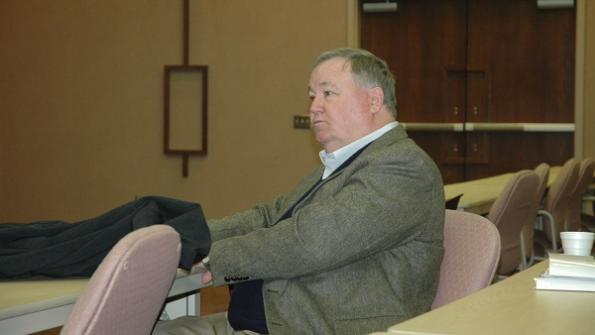
Mark Lange, President and CEO of the National Cotton Council, hit the highlights of the farm bill that finally passed the U.S. House and Senate Agriculture Committees Jan. 27, and then cast a wider net to address issues with China, the World Trade Organization, Peru and a new initiative to support U.S. and Australian cotton.

Mark Lange, President and CEO of the National Cotton Council, hit the highlights of the farm bill that finally passed the U.S. House and Senate Agriculture Committees Jan. 27, and then cast a wider net to address issues with China, the World Trade Organization, Peru and a new initiative to support U.S. and Australian cotton.
“It took three years to get a farm bill,” Lange said in the opening address at the inaugural Red River Crops Conference in Altus.
He praised Oklahoma Representative Frank Lucas, Chairman of the House Agriculture Committee, for his leadership and persistence in pushing for legislation that would provide farmers with a needed safety net.
He noted some changes, including the Stacked Income Protection Plan (STAX), that will not take full effect until next year. “Producers will have the option to purchase STAX or a Supplemental Coverage Option (SCO) on all acres planted to cotton.”
A $125,000 payment limitation is in place for Title I programs but not insurance payments. Also, an adjusted gross income (AGI) limitation of $900,000 will be in place, but that will not include crop insurance subsidies.
If you want to learn more about the new farm bill and cotton issues, please check out Southwest Farm Press Daily and receive the latest news right to your inbox.
Labor requirements to be eligible for “actively engaged” status has been dropped but the provision “authorizes the Secretary to define what constitutes a significant contribution of management; and the Secretary has the discretion to establish a limit on who may be considered actively engaged when a significant contribution of management is used to meet the actively engaged requirements.
“The new management requirements for actively engaged do not apply to individuals or entities comprised solely of family members.”
The Market Assistance Loan remains in place.
Lange said the legislation is different from previous farm bills and will require considerable time for the USDA to write the rules.
Trade issues
He turned to trade issues and noted that a Peruvian commission (The National Institute for the Defense of Competition and the Protection of Intellectual Property) had decided not to impose a countervailing duty on U.S. cotton imports. The commission “could not conclude a causal relationship between imports of U.S. cotton and Peruvian cotton producers’ economic situation,” Lange said. “They cited other issues, such as exchange rates.”
Peru had 15 days to appeal the decision but did not appeal. “The case is now formally closed,” Lange said. Another issue came out of INDECOPI’s investigation into cotton. The body “has found against China in an anti-dumping investigation of textile imports and will impose duties on 34 tariff lines.”
Lange said continuing WTO discussions have also opened up conversations on transparency in cotton programs. He said following the Brazil Case, the U.S. Cotton Program is very transparent. “That’s not the case for other producers.”
He also commented on changes in China’s domestic cotton policy. Meetings in early November between NCC and Cotton Council International (CCI) with some 25 Chinese officials were designed to explain U.S. cotton programs—from 1980 to the present. A follow-up meeting occurred in early January.
Through those discussions participants learned that China is changing its national reserve policy and will make Xinjiang a pilot region for a target price. That target will not be available to growers on the Eastern Seaboard, Lange said. The new policy also includes “reduced amounts of sliding scale quota in 2014 and pricing more subject to market influences.”
Lange also commented on a new program—Cotton Leads—that promotes U.S. and Australian cotton as “responsibly grown.”
“Cotton producers in Australia and the U.S. have substantially reduced the environmental footprint of cotton,” Lange said. “We want to promote that.”
Participants will include cotton producers from both countries with non-government organizations, and private industry partners. Producers will make up the board with partners as advisors. Participating parties will bear no cost, and the program will be managed as a Cotton Foundation Special Project.
“Over 50 textile companies have joined,” as partners, Lange said.
Partners accept that Australian and U.S. cotton is “responsibly produced and encourage their suppliers to use Australian and U.S. Cotton.”
Lange said the program would not be possible without the support of Field to Market, an alliance for sustainable agriculture.
He also noted that U.S. cotton producers have a good environmental success story to tell. From 1980 through 2011, U.S. cotton producers cut land use by 30 percent, soil loss by 68 percent, irrigation water use by 75 percent, energy use by 31 percent and greenhouse gas emissions by 22 percent.
“Cotton growers do an extraordinary job of reducing the environmental footprint,” Lange said.
The two-day Red River Crops Conference is a joint endeavor of Oklahoma and Texas Research and Extension to discuss crop production issues common to southwest Oklahoma and the Texas Rolling Plains. The first day is devoted to cotton and the second to other crops common to the region.
The conference will alternate between Texas and Oklahoma.
Also of interest:
Improving soil, diversification is crucial for better cotton
Rotation, variety selection, timeliness are critical for SW high cotton…
About the Author(s)
You May Also Like





